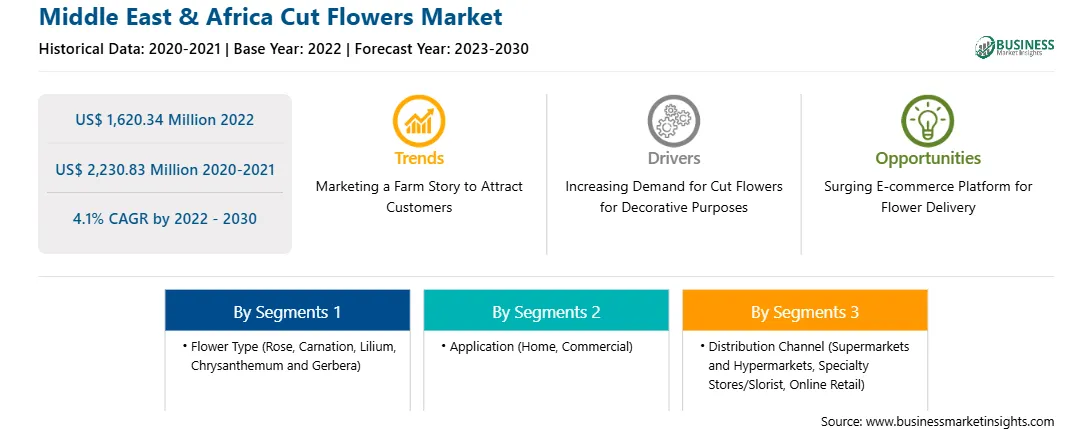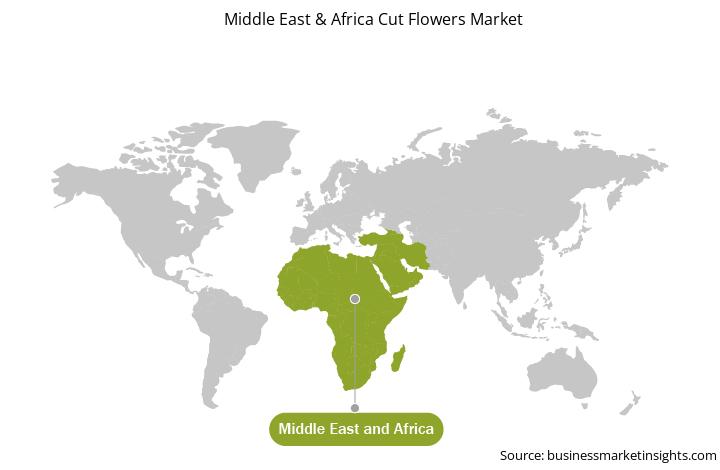The Middle East & Africa cut flowers market is expected to grow from US$ 1,620.34 million in 2022 to US$ 2,230.83 million by 2030. It is estimated to grow at a CAGR of 4.1% from 2022 to 2030.
Consumers are willing to pay for products that come with a story. This can be related to products grown by smallholders, locally produced items, or products with special characteristics such as unique colors or longer vase life. Storytelling connects consumers with a product and often justifies a price premium. Products from developing countries can obtain a distinctive position in the market by emphasizing their origins and good agricultural practices. Growing demand for niche products offers opportunities for growers to distinguish themselves. With increasing competition from other gift products, it becomes ever more important to emphasize the unique characteristics of products by providing additional product information through storytelling on the packaging or website. Demand for Fairtrade flowers, for example, is still growing and is expected to keep growing at a higher rate than total market demand. As people become keen on knowing the source of their flowers, marketing a farm story is expected to become a future trend.
The Middle East & Africa cut flowers market is segmented into Saudi Arabia, South Africa, the UAE, and the Rest of the Middle East & Africa. There is a high demand for tropical cut flowers as eye-catching elements in flower arrangements for office lobbies and hotels in this region. Freshly cut roses, orchids, carnations, and lilies, among others, have been in great demand in the region. Cut flowers hold a cultural significance in many Middle Eastern and African societies. They are often used in traditional ceremonies, weddings, and religious rituals, and in religious offerings such as Eid al-Fitr, Eid al-Adha, and Easter. Weddings are grand affairs in the Middle East & Africa, with floral decoration as the central part of these celebrations.
The demand for cut flowers is also surging with the rising preference of consumers toward home and office decorations. The blooming hospitality industry in the region, with luxury hotels and resorts, requires a constant supply of cut flowers for decoration. As a result, key players in the cut flowers market have been investing in mergers, acquisitions, and collaborations. For instance, in February 2022, Camelia Flowers announced its expansion in the UAE by opening a state-of-the-art shop designed by an expert interior decoration team.
Strategic insights for the Middle East & Africa Cut Flowers provides data-driven analysis of the industry landscape, including current trends, key players, and regional nuances. These insights offer actionable recommendations, enabling readers to differentiate themselves from competitors by identifying untapped segments or developing unique value propositions. Leveraging data analytics, these insights help industry players anticipate the market shifts, whether investors, manufacturers, or other stakeholders. A future-oriented perspective is essential, helping stakeholders anticipate market shifts and position themselves for long-term success in this dynamic region. Ultimately, effective strategic insights empower readers to make informed decisions that drive profitability and achieve their business objectives within the market. The geographic scope of the Middle East & Africa Cut Flowers refers to the specific areas in which a business operates and competes. Understanding local distinctions, such as diverse consumer preferences (e.g., demand for specific plug types or battery backup durations), varying economic conditions, and regulatory environments, is crucial for tailoring strategies to specific markets. Businesses can expand their reach by identifying underserved areas or adapting their offerings to meet local demands. A clear market focus allows for more effective resource allocation, targeted marketing campaigns, and better positioning against local competitors, ultimately driving growth in those targeted areas.Middle East & Africa Cut Flowers Strategic Insights

Middle East & Africa Cut Flowers Report Scope
Report Attribute
Details
Market size in 2022
US$ 1,620.34 Million
Market Size by 2030
US$ 2,230.83 Million
Global CAGR (2022 - 2030)
4.1%
Historical Data
2020-2021
Forecast period
2023-2030
Segments Covered
By Flower Type
By Application
By Distribution Channel
Regions and Countries Covered
Middle East and Africa
Market leaders and key company profiles
Middle East & Africa Cut Flowers Regional Insights

The Middle East & Africa cut flowers market is segmented into flower type, application, distribution channel, and country.
Based on flower type, the Middle East & Africa cut flowers Market is segmented into rose, carnation, lilium, chrysanthemum and gerbera, and others. The rose segment held the largest share of the Middle East & Africa cut flowers market in 2022.
In terms of application, the Middle East & Africa cut flowers Market is bifurcated into home and commercial. The commercial segment held a larger share of the Middle East & Africa cut flowers market in 2022.
By distribution channel, the Middle East & Africa cut flowers market is categorized into supermarkets and hypermarkets, specialty stores/florist, online retail, and others. The specialty stores/florist segment held the largest share of the Middle East & Africa cut flowers market in 2022.
Based on country, the Middle East & Africa cut flowers market is segmented into South Africa, Saudi Arabia, the UAE, and the Rest of Middle East & Africa. The Rest of Middle East & Africa dominated Middle East & Africa cut flowers market in 2022.
Selecta Cut Flowers SAU, Multiflora Corp, Rosebud Ltd, Karen Roses Ltd, Dummen Orange Holding BV, and Marginpar BV are some of the leading companies operating in the Middle East & Africa cut flowers market.
The Middle East & Africa Cut Flowers Market is valued at US$ 1,620.34 Million in 2022, it is projected to reach US$ 2,230.83 Million by 2030.
As per our report Middle East & Africa Cut Flowers Market, the market size is valued at US$ 1,620.34 Million in 2022, projecting it to reach US$ 2,230.83 Million by 2030. This translates to a CAGR of approximately 4.1% during the forecast period.
The Middle East & Africa Cut Flowers Market report typically cover these key segments-
The historic period, base year, and forecast period can vary slightly depending on the specific market research report. However, for the Middle East & Africa Cut Flowers Market report:
The Middle East & Africa Cut Flowers Market is populated by several key players, each contributing to its growth and innovation. Some of the major players include:
The Middle East & Africa Cut Flowers Market report is valuable for diverse stakeholders, including:
Essentially, anyone involved in or considering involvement in the Middle East & Africa Cut Flowers Market value chain can benefit from the information contained in a comprehensive market report.